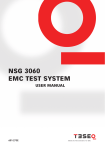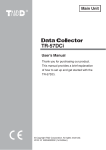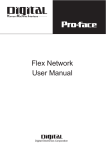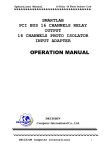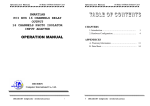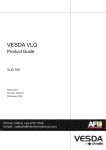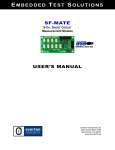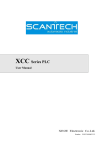Download Xtralis XCC Product Guide
Transcript
Xtralis Class C (XCC) Product Guide XCC-011 June 2012 D/N: 19137_08 P/N: 29698 Xtralis Pty Ltd Xtralis XCC-011 Product Guide Intellectual Property and Copyright This document includes registered and unregistered trademarks. All trademarks displayed are the trademarks of their respective owners. Your use of this document does not constitute or create a licence or any other right to use the name and/or trademark and/or label. This document is subject to copyright owned by Xtralis AG (“Xtralis”). You agree not to copy, communicate to the public, adapt, distribute, transfer, sell, modify or publish any contents of this document without the express prior written consent of Xtralis. Disclaimer The contents of this document is provided on an “as is” basis. No representation or warranty (either express or implied) is made as to the completeness, accuracy or reliability of the contents of this document. The manufacturer reserves the right to change designs or specifications without obligation and without further notice. Except as otherwise provided, all warranties, express or implied, including without limitation any implied warranties of merchantability and fitness for a particular purpose are expressly excluded. General Warning This product must only be installed, configured and used strictly in accordance with the General Terms and Conditions, User Manual and product documents available from Xtralis. All proper health and safety precautions must be taken during the installation, commissioning and maintenance of the product. The system should not be connected to a power source until all the components have been installed. Proper safety precautions must be taken during tests and maintenance of the products when these are still connected to the power source. Failure to do so or tampering with the electronics inside the products can result in an electric shock causing injury or death and may cause equipment damage. Xtralis is not responsible and cannot be held accountable for any liability that may arise due to improper use of the equipment and/or failure to take proper precautions. Only persons trained through an Xtralis accredited training course can install, test and maintain the system. Liability You agree to install, configure and use the products strictly in accordance with the User Manual and product documents available from Xtralis. Xtralis is not liable to you or any other person for incidental, indirect, or consequential loss, expense or damages of any kind including without limitation, loss of business, loss of profits or loss of data arising out of your use of the products. Without limiting this general disclaimer the following specific warnings and disclaimers also apply: Fitness for Purpose You agree that you have been provided with a reasonable opportunity to appraise the products and have made your own independent assessment of the fitness or suitability of the products for your purpose. You acknowledge that you have not relied on any oral or written information, representation or advice given by or on behalf of Xtralis or its representatives. Total Liability To the fullest extent permitted by law that any limitation or exclusion cannot apply, the total liability of Xtralis in relation to the products is limited to: i. in the case of services, the cost of having the services supplied again; or ii. in the case of goods, the lowest cost of replacing the goods, acquiring equivalent goods or having the goods repaired. Indemnification You agree to fully indemnify and hold Xtralis harmless for any claim, cost, demand or damage (including legal costs on a full indemnity basis) incurred or which may be incurred arising from your use of the products. Miscellaneous If any provision outlined above is found to be invalid or unenforceable by a court of law, such invalidity or unenforceability will not affect the remainder which will continue in full force and effect. All rights not expressly granted are reserved. www.xtralis.com i Xtralis XCC-011 Product Guide Xtralis Pty Ltd Document Conventions The following typographic conventions are used in this document: Convention Description Bold Used to denote: emphasis Used for names of menus, menu options, toolbar buttons Italics Used to denote: references to other parts of this document or other documents. Used for the result of an action. The following icons are used in this document: Convention Description Caution: This icon is used to indicate that there is a danger to equipment. The danger could be loss of data, physical damage, or permanent corruption of configuration details. Warning: This icon is used to indicate that there is a danger of electric shock. This may lead to death or permanent injury. Warning: This icon is used to indicate that there is a danger of inhaling dangerous substances. This may lead to death or permanent injury. Contact Us The Americas +1 781 740 2223 Asia +852 2916 8894 Australia and New Zealand +61 3 9936 7000 UK and Europe +44 1442 242 330 Middle East +962 6 569 1083 www.xtralis.com ii www.xtralis.com Xtralis Pty Ltd Xtralis XCC-011 Product Guide Codes and Standards Information for Air Sampling Smoke Detection We strongly recommend that this document is read in conjunction with the appropriate local codes and standards for smoke detection and electrical connections. This document contains generic product information and some sections may not comply with all local codes and standards. In these cases, the local codes and standards must take precedence. The information below was correct at time of printing but may now be out of date, check with your local codes, standards and listings for the current restrictions. FCC Compliance Statement This equipment has been tested and found to comply with the limits for a Class B digital device, pursuant to part 15 of the FCC Rules. These limits are designed to provide reasonable protection against harmful interference in a residential installation. This equipment generates, uses and can radiate radio frequency energy and, if not installed and used in accordance with the instruction, may cause harmful interference to radio communications. However, there is no guarantee that interference will not occur in a particular installation. If this equipment does cause harmful interference to radio or television reception, the user is encouraged to try to correct the interference by one or more of the following measures; re-orientate or relocate the receiving antenna, increase the separation between the equipment and receiver, connect the equipment to a power outlet which is on a different power circuit to the receiver or consult the dealer or an experienced radio/television technician for help. FDA This Xtralis product incorporates a laser device and is classified as a Class 1 laser product that complies with FDA regulations 21 CFR 1040.10. The laser is housed in a sealed detector chamber and contains no serviceable parts. The laser emits invisible light and can be hazardous if viewed with the naked eye. Under no circumstances should the detector chamber be opened. EN54-20 The product must use a power supply conforming to EN54: Part 4. This product is compliant with EN54-20 sensitivity requirements, provided that a pipe network conforming to the design parameters provided in Chapter 2 is used. Product Listings l l l l l l LPCB VdS CE - EMC and CPD EN54-20 : Class C - 18 Holes / Threshold I and the minor low and minor high air flow thresholds are set at 85% and 115% respectively EN61000-6-3 EN50130-4 Regional approvals listings and regulatory compliance vary between Xtralis product models. Refer to www.xtralis.com for the latest product approvals matrix. Document: 19137_08 Part Number: 29698 www.xtralis.com iii Xtralis XCC-011 Product Guide Xtralis Pty Ltd This page is intentionally left blank. iv www.xtralis.com Xtralis Pty Ltd Xtralis XCC-011 Product Guide Table of Contents 1 2 3 Introduction 3 1.1 Features 4 Pipe Networks 5 2.1 2.2 6 7 Wiring Connections 3.1 3.2 3.3 3.4 3.5 3.6 3.7 3.8 4 5 6 7 XCC-011 with Drilled Holes XCC-011 with Capillaries Termination Card Relay Terminals Relay settings and conditions to change states Auxiliary / GPI Terminals Programming Socket Typical Wiring to a Fire Panel with an EOL Resistor Wiring to an Addressable Loop Module Power Source 9 9 9 9 10 11 11 11 12 Installation 13 4.1 4.2 4.3 4.4 4.5 4.6 13 14 15 16 16 17 Mounting the Detector Connection to Pipe Network Battery Backup Startup Commissioning Installation Checklist Operation 19 5.1 19 Display Maintenance and Servicing 21 6.1 6.2 6.3 6.4 21 22 23 24 Internal Components Opening and Closing the Detector Replacing the Filter Cartridge Replacing the Aspirator Product Information 25 7.1 7.2 7.3 7.4 25 26 28 28 Specifications Dimensions Default Settings Spare Parts Index www.xtralis.com 29 1 Xtralis XCC-011 Product Guide Xtralis Pty Ltd This page is intentionally left blank. 2 www.xtralis.com Xtralis Pty Ltd 1 Xtralis XCC-011 Product Guide Introduction The Xtralis Class C (XCC) detector is an Air-sampling Smoke Detector designed to protect commercial facilities of up to 1600m² to EN 54-20 Class C sensitivity levels. The detector monitors the environment for conditions that indicate the presence or potential of a fire and annunciates via indicators and relay outputs. This Product Guide provides you with comprehensive knowledge of the detector. It includes instructions on installing, cabling and powering up the XCC detector. It also provides information on the features, technical specifications and an understanding of the components and their function. This guide is for anyone involved with the design, maintenance and purchasing of a system that includes the XCC detector. It is assumed that anyone using this guide has knowledge and the appropriate certification from the local fire and electrical authorities. Figure 1-1: XCC Detector www.xtralis.com 3 Xtralis XCC-011 Product Guide 1.1 Xtralis Pty Ltd Features The XCC features make it an ideal smoke detection apparatus for protecting a wide range of Class C environments. The features include: l l l l l l l l l l 4 The XCC-011 detector can cover an area of up to 1600m² Multiple Fire-Alarm threshold settings for specified pipe networks Fire-Alarm and Pre-Alarm outputs One pipe inlet that can be split into two pipes Option for inverted mounting High efficiency aspirator Air flow monitoring Easy cable termination Programmable general purpose input Configuration and maintenance via Xtralis VSC software www.xtralis.com Xtralis Pty Ltd 2 Note: Xtralis XCC-011 Product Guide Pipe Networks To achieve EN 54-20 Class C compliance you must use the pre-engineered pipe networks described in this section. These pre-engineered pipe networks provide installations which have a sensitivity better than 8.5% obscuration/m and predicted transport time of better than 70s. This ensures that they have a good margin of performance as a Class C detector and allow hole positions along the pipe to be varied from exact equal spacing while still achieving an acceptable system balance. Wherever possible the hole sizes have been restricted to increments of 0.5mm and a maximum of two hole sizes on any one detector (e.g. 3mm holes with last hole 3.5mm). However, this is not always possible, particularly on the designs using capillary sampling. For these, more than two drills sizes are often needed on a particular design to accommodate the flexibility given for the length of capillary pipes – being from 0.25m to 4m long (Note: capillaries should be equal lengths for a particular detector). Fire-Alarm Threshold Settings: There are 4 sensitivity thresholds provided on the XCC detector to accommodate different numbers of holes, pipe lengths and pipe arrangements. These are denoted I, II, III and IV (with I being the most sensitive). Pre-Alarm Threshold Settings: The Pre-alarm condition on the XCC detector is signaled at 70% of Fire-Alarm Threshold Settings. The tables in the following sections define the pre-engineered systems allowed. Refer to Figure 2-1 and Figure 2-2 below for examples of single pipe and single branch (U-style) pipe networks. Figure 2-1: Single pipe network Figure 2-2: Branch Pipe network www.xtralis.com 5 Xtralis XCC-011 Product Guide 2.1 Xtralis Pty Ltd XCC-011 with Drilled Holes For the given pipe lengths and number of holes use a hole size in the indicated range shown in Table 2-1 or Table 2-2. All holes to be the same size and evenly spaced (+/- 20%). The final hole can be in the end-cap or in the pipe with a sealed end-cap. Table 2-1: Pre-engineered pipe networks for XCC-011 with drilled holes - single pipe Pipe Style Length (m) Number of Holes / Pipe 4 to 8 Single Pipe 80 - 110 50 - 80 n/a use XCC-010 9 10 11 12 13 14 15 1-3=2mm 16 5-8=3mm 9=3mm 10=3mm 11=3mm 3-11=2.5mm 4-12=2.5mm 5-13=2.5mm 5-14=2.5mm 5-15=2.5mm 7-16=2.5mm 9=5mm 10=5mm 11=5mm 12=5mm 12=3mm 13=3mm 14=3mm 15=3mm 16=3mm 17=3mm 13=5mm 14=5mm 15=5mm 16=5mm 17=5mm 18=5mm 1-8=3mm 1-9=3mm 1-9=2.5mm 1-10=2.5mm 1-11=2.5mm 1-12=2.5mm 1-13=2.5mm 1-13=2.5mm 1-14=2.5mm 1-7=2mm 9=4mm 10=4mm 10-11=3mm 11-12=3mm 13-14=3mm 14-15=3mm 1-4=2mm 18 1-10=2.5mm 1-2=2mm 12-13=3mm 1-4=2mm 17 1-4=2.5mm 1-8=2.5mm 1-9=2.5mm 1-4=2mm 14-16=3mm 1-6=2mm 15-17=3mm 8-17=2.5mm 18=3mm < 50 use XCC-010 Fire Alarm Threshold Setting III all=3mm III all=3mm II all=3mm all=2.5mm II all=2.5mm I all=2.5mm I all=2.5mm I all=2.5mm I all=2.5mm I I all=2.5mm I Table 2-2: Pre-engineered pipe networks for XCC-011 with drilled holes - single branch Pipe Style Branch Length Number of Holes / Branch 4 Single Branch 60 - 80 all=4mm 6 7 8 9 1-5=3mm 1-6=2.5mm 1-7=2.5mm 1-8=2.5mm 6=4mm 7=4mm 8=4mm 9=4mm 1-8=2.5mm 40 - 60 all=4.5mm all=4mm all=3.5mm all=3mm 1-8=2.5mm 9=3mm 9=3.5mm < 40 all=4.5mm all=4mm all=3.5mm all=3mm all=3mm all=3mm I I Fire Alarm Threshold Setting 6 all=4.5mm 5 IV III II I www.xtralis.com Xtralis Pty Ltd 2.2 Xtralis XCC-011 Product Guide XCC-011 with Capillaries For the given pipe lengths and number of capillary pipes use a hole size as indicated in Table 2-3 or Table 2-4 with a capillary length of between 0.5m and 4m. All capillaries are to be the same length and evenly spaced (+/- 20%). The end of the pipe is to be sealed with an end-cap. Table 2-3: Pre-engineered pipe networks for XCC-011 with capillaries - single pipe Pipe Style Length (m) Number of Capillaries / Pipe 4 to 8 Single Pipe 80 - 110 50 - 80 n/a 9 10 11 12 13 14 1-4=2.5mm 1-8=2.5mm 1-9=2.5mm 1-10=2.5mm 1-2=2mm use XCC-010 15 1-3=2mm 16 1-4=2mm 17 1-4=2mm 1-6=2mm 18 10-16=2mm 5-8=3mm 9=3mm 10=3mm 11=3mm 3-11=2.5mm 4-12=2.5mm 5-13=2.5mm 5-14=2.5mm 7-15=2.5mm 17=3mm 9=5mm 10=5mm 11=5mm 12=5mm 12=3mm 13=3mm 14=3mm 15=3mm 16=3mm 13=5mm 14=5mm 15=5mm 16=5mm 17=5mm 18=5mm 1-9=3mm 1-9=3mm 1-10=3mm 1-11=2.5mm 1-12=2.5mm 1-13=2.5mm 1-14=2.5mm 1-13=2.5mm 1-14=2.5mm 1-7=2mm 10=4mm 10=4mm 11=4mm 12=3mm 13=3mm 14=3mm 15=3mm 14-16=3mm 15-17=3mm 8-17=2.5mm 18=3mm < 50 use XCC-010 Fire Alarm Threshold Setting all=3mm II II all=3mm II all=3mm II all=3mm all=3mm I all=3mm I all=3mm I all=3mm I all=3mm I I all=2.5mm I Table 2-4: Pre-engineered pipe networks for XCC-011 with capillaries - single branch Pipe Style Branch Length Number of Capillaries / Branch 4 Single Branch 6 40 - 50 all=4.5mm all=4mm 1-5=3mm 6=4mm 30 - 40 all=4.5mm all=4mm all=3.5mm < 30 Fire Alarm Threshold Setting www.xtralis.com 5 all=4.5mm IV all=4mm III all=3.5mm II 7 1-6=2.5mm 8 9 1-7=2.5mm 1-8=2.5mm 7=4mm 8=4mm 9=4mm all=3mm 1-8=2.5mm 1-8=2.5mm 9=3mm 9=3.5mm all=3mm all=3mm I I all=3mm I 7 Xtralis XCC-011 Product Guide Xtralis Pty Ltd This page is intentionally left blank. 8 www.xtralis.com Xtralis Pty Ltd 3 3.1 Xtralis XCC-011 Product Guide Wiring Connections Termination Card The Termination Card acts as the interface for PC configuration, Power Supply Terminals and Relay Terminals. Terminal A Terminal B 1 FIRE-ALARM (NO) 1 Bias (-) (GND) 2 FIRE-ALARM (C) 2 Reset (-) (GPI) 3 PRE-ALARM (NO) 3 Reset (+) (GPI) 4 PRE-ALARM (C) 4 Bias (+) 5 FAULT (NO) 5 LED (-) (GND) 6 FAULT (C) 6 LED (+) 7 FAULT (NC) 7 Power (-) 8 Power (+) 9 Power (-) 10 Power (+) Legend A Terminal A C Relays B Terminal B D 1.6A Fuse E Programming Socket Figure 3-1: Termination Card 3.2 Relay Terminals There are three relays designated Fault, Pre-Alarm and Fire. The relays can be used to connect to the fire alarm control panel or to activate external devices. The Fire-Alarm and Pre-Alarm relay states are nonenergized and the Fault relay set to energized on power up (de-energized on Fault). 3.3 Relay settings and conditions to change states Table 3-1: Default relay settings and conditions to change state Relay # Relay Condition for relay to change state 1 Fault This relay is de-energized when one of the following conditions occur: l l l Fault found on detector Air flow normalization is initiated System isolation is initiated 2 Pre-Alarm This relay is energized when the unit detects a potential fire event. 3 Fire www.xtralis.com This relay is energized once the unit detects a fire. 9 Xtralis XCC-011 Product Guide 3.4 Xtralis Pty Ltd Auxiliary / GPI Terminals The Reset (GPI) terminals are used for either Reset, Mains OK or Standby functions (refer to Table 3-2). Note that Xtralis VSC configuration is required to select the required GPI function. There are two connection methods available for the GPI input: l l Method 1: Use the Bias terminals which provide 10 VDC supply to initiate the required GPI function (Figure 3-2). Method 2: Use an external power supply (5-24 V). Connect the Reset (+) terminal to the positive output and the Reset (-) terminal to the ground output of the external power supply. Note the voltage input to Reset (+) and Reset (-) terminals is isolated from the system by an opto-coupler device. The Bias, Reset (GPI) and LED terminals are located on the termination card (Figure 3-1). The LED terminals provide a 5V, 15 mA DC supply via an internal 220 ohm resistor to power a remote LED. Legend Pins A Switch 1 Bias (-) B LED 2 Reset (-) 3 Reset (+) 4 Bias (+) Switch Disable Close Position 5 LED (+) Reset Open Position 6 LED (-) Figure 3-2: Wire connection for Auxiliary/GPI Terminals Table 3-2: GPI Functions Function State Change Mains OK The detector monitors the state of the external power supply and responds to the following conditions. Mains OK ≥ 5 VDC is at this terminal. Mains Fail ≤ 2 VDC is at this terminal. Standby Mode The detector is Disabled and the aspirator turns OFF when ≥5 VDC is at this terminal. No Alarms can be generated in this state. Reset / Disable While power is applied to the GPI the detector is disabled. In addition, the connection of power to the GPI resets the unit. ≥ 5 VDC Detector Disables. ≤ 2 VDC Detector Reset. 10 www.xtralis.com Xtralis Pty Ltd 3.5 Xtralis XCC-011 Product Guide Programming Socket The 9 pin programming socket on the termination card provides the communication interface between the detector and a PC running Xtralis VSC. Connect the PC to the detector using a RS232 data cable directly to the 9 pin programming socket. 3.6 Typical Wiring to a Fire Panel with an EOL Resistor The diagram below shows the correct way to wire XCC detectors to a conventional fire alarm control panel (FACP). It also shows where an End Of Line (EOL) resistor is correctly installed. Legend Line Impedance A Fire Relay EOL Quiescent B Pre-Alarm Relay Short Fire Alarm C Fault Relay D GPI Input E Conventional Loop Input F Reset Contact G To next detector or EOL resistor Open Fault Figure 3-3: Typical wiring to a fire panel with EOL resistor 3.7 Wiring to an Addressable Loop Module This wiring example is for wiring XCC detectors to a typical Input/Output Loop module (3 input 1 output). These are example drawings. Refer to the appropriate product manual for the exact wiring details of the third party equipment. Legend Line Impedance A Fire Relay EOL Quiescent B Pre-Alarm Relay Fire Fire Alarm C Fault Relay Open Wiring Fault D GPI Input Short Detector Fault E Fire F EOL G Input 1 H Input 2 I Output (configured on reset) Figure 3-4: Typical wiring to an input/output loop module www.xtralis.com 11 Xtralis XCC-011 Product Guide 3.8 Xtralis Pty Ltd Power Source The power terminals on the termination card connect to a 24VDC power supply. The four power terminals enable power to be brought into the detector and looped out to another device. The detector has reverse polarity protection to minimize the risk of reverse power connection to the detector. Note: The XCC detector will not operate when the power supply is reversed. Note: Operating the detector outside the DC supply voltage range of 18VDC and 30VDC may cause damage to the device. Legend A Power Terminal B From 24V Power Supply C Power (-) D Power (+) E 24V Power to Next Device Pins 7,9 GND 8,10 +24V Figure 3-5: Wire connection details for power terminals on termination card 12 www.xtralis.com Xtralis Pty Ltd 4 Xtralis XCC-011 Product Guide Installation 4.1 Mounting the Detector The XCC detector can be mounted onto the wall using the mounting bracket on any suitable secure surface. Note: 4.1.1 The detector can only be mounted using the mounting bracket included with the packaging. Securing the mounting bracket The mounting bracket for the XCC detector is always mounted in the UP direction. The mounting bracket is clearly marked with the word "UP" and an upward pointing arrow. A 205.0mm 8.07in Legend A Tab B This side to Detector C C B Figure 4-1: The mounting bracket for normal and inverted orientations Secure the mounting bracket to the surface using appropriate fasteners, ensuring that the bracket is horizontally straight and sits flush on the surface. Determine the ports for cable entry. Press out the tabs for the cable entry, air inlet and air exhaust ports. 4.1.2 Installing the Detector Determine the orientation for mounting the XCC detector. Remove the front cover and if necessary separate it from the enclosure box. The back of the enclosure box is slotted over the four mounting bracket tabs. Slide the detector downwards until it slides onto the tabs. Screw in the anti-tamper screw. Check to confirm that the detector does not slide off the mounting bracket. Legend A Back of Detector B Rectangle Slots C Mounting Bracket D Bracket Tab Figure 4-2: Mounting the detector onto the mounting bracket www.xtralis.com 13 Xtralis XCC-011 Product Guide 4.2 Connection to Pipe Network 4.2.1 Inlet Pipes Xtralis Pty Ltd To connect the detector to the Pipe Network: 1. Ensure a minimum length of 500 mm (20 in.) of straight pipe before terminating the pipe at the air inlet port of the detector. 2. Square off and de-burr the end of the sampling air pipe, ensuring the pipe is free from debris. 3. Insert the pipe into the inlet port ensuring a firm fit. DO NOT glue the inlet pipes to the Pipe Inlet Manifold. 4.2.2 Air Exhaust Pipe Unplug the air exhaust port at the bottom of the detector. If necessary pipe the exhaust back to the protected area. The maximum suggested length for the exhaust pipe is 4 m (13 ft.). Note: 14 Refer to and fill in Installation Checklist on page 17. www.xtralis.com Xtralis Pty Ltd 4.3 Xtralis XCC-011 Product Guide Battery Backup The power supply for the XCC detector may be switched to a back up battery in the event of the supply being disrupted. The size of the battery back up is determined by local standards and codes, the total power required by the system, back up time required, allowance for reduction in capacity with age and expected temperature variations. Note: It is recommended that batteries be changed as per the battery manufacturer’s specifications or as per your local codes and standards. 4.3.1 Backup Battery size calculation sheet Table 4-1: Calculating the size of the backup battery XCC-011 Normal Load @ 24 VDC Equipment Load mA Detector 235 255 Total mA Total mA Number Full alarm load @ 24 VDC Total Load mA Number Total Other 24 V loads X Standby hours X Alarm hours = Standby capacity Alarm capacity Total capacity = Standby + Alarm capacity Divided by 1000 for standby capacity Multiplied by battery factor (Normally 1.25) www.xtralis.com 15 Xtralis XCC-011 Product Guide 4.4 Startup Note: An XCC detector must only be powered up by accredited personnel. Xtralis Pty Ltd After installing the XCC detector it is necessary to power up the system. The system takes approximately 15 seconds to power up. If the system fails to power up, check all power wires are secured to its terminals and the polarities of the power wires are correctly terminated. On power up: l l The aspirator starts up The LED indicators on the XCC front cover: n Will light up and cycle on and off n If a fault has been detected the FAULT LED indicator will remain illuminated n If the system is functioning normally the OK LED indicator will remain illuminated n If the detector does not behave normally on power up, contact your commissioning engineer or distributor to troubleshoot. Note: It is normal for the detector to display troubles immediately after power up. Reset the detector by pressing the reset button on the front cover of the detector to unlatch the relays and fault LED. If the fault LED on the front cover continues to be illuminated, proceed with the preliminary systems check. 4.5 Commissioning Commissioning follows installation and power-up of the detector and involves the following steps: 1. Use Xtralis VSC to: l Accept factory default configurations. l Check that the fire-alarm threshold setting is appropriate to the pre-engineered design used. l Select appropriate air flow threshold setting. l Normalize the air flow. 2. Functionally test the detector by introducing smoke into the last hole. 3. Record and confirm the transport time is less than 90 seconds. 16 www.xtralis.com Xtralis Pty Ltd 4.6 Xtralis XCC-011 Product Guide Installation Checklist Site Name Address Detector Serial Number(s) and Date of Manufacture Name of Installer Signature Date Perform the following checks listed below to ensure that all the necessary items are completed before handing over to a commissioning engineer. Installation Checks Yes No Were the detector and the mounting bracket intact in the box? Is the detector securely locked onto its mounting bracket? Is the sampling air pipe firmly connected to the air inlet port? Ensure the pipe is NOT glued. Have the power wires been connected to the correct terminals on the detector? If required, has the end of line resistor been connected? Have the alarm signaling wires been terminated to the correct terminals of the detector? Has the plug at the exhaust port been removed and the exhaust pipe (if fitted) not glued? Has the front cover been replaced correctly? Is the air sampling pipework installed and checked as per the site plans? www.xtralis.com 17 Xtralis XCC-011 Product Guide Xtralis Pty Ltd This page is intentionally left blank. 18 www.xtralis.com Xtralis Pty Ltd 5 5.1 Xtralis XCC-011 Product Guide Operation Display A Fire-Alarm This LED is illuminated when the unit detects a fire. B Pre-Alarm This Pre-Alarm LED is illuminated when the unit detects a potential fire event developing. C Fault This LED is illuminated when a fault is detected. It is also illuminated during airflow normalization. D OK This LED stays illuminated during normal operation indicating the detector is functioning normally. This LED flashes twice repeatedly during air flow normalization. E Reset / Disable This LED is illuminated when detector is disabled. While it remains disabled the Fault relay is deenergized (indicating a fault condition) and the PreAlarm and Fire-Alarm relays will not activate in the case of an alarm. l l F Reset / Disable Push Button l l To Reset the unit, press button once. To Disable the unit, press and hold button for 3 seconds. To Enable the unit, press and hold button for 3 seconds. While Disabled, faults may be cleared by pressing button once. The button will not operate: l l if an external disable or standby command is activated using the GPI (refer to Auxiliary / GPI Terminals on page 10), or; if the Reset/Disable button has been locked out in the programming. Figure 5-1: LED Indicators and the Reset/Disable button www.xtralis.com 19 Xtralis XCC-011 Product Guide Xtralis Pty Ltd This page is intentionally left blank. 20 www.xtralis.com Xtralis Pty Ltd 6 Xtralis XCC-011 Product Guide Maintenance and Servicing To maintain the XCC detector at its peak performance the maintenance schedule given below should be followed. Maintenance can be conducted by the original installer, a distributor, or a service contractor. Table 6-1: Maintenance schedule for the XCC detector Maintenance Check Quarterly Power Supply Check Pipe Network Caution: Note: l l 6.1 Six Monthly Annual Biennial X X Filter Inspection X Pipe Integrity Smoke Test X Check Pipe Flow X Clean Sampling Point X Flush Pipe Network X While a XCC detector is disabled, it will not report Fire events to the FACP. Prior to any maintenance or testing: Inform appropriate supervising authority about the risk associated with disabling a detector. Ensure that any ancillary devices dependent on the XCC detector is/are disabled before work is begun. Internal Components Legend A 9 pin programming socket B Termination card C Serial number D Air filter cartridge E Filter screw F Air exhaust port G Aspirator H 1.6A fuse I Anti-tamper screw J Cable entry points K Air inlet port L Wire terminal strips Figure 6-1: View of key components inside the XCC detector www.xtralis.com 21 Xtralis XCC-011 Product Guide 6.2 Xtralis Pty Ltd Opening and Closing the Detector Figure 6-2: Opening and closing the detector 6.2.1 Opening 1. Undo the two screws on front cover. 2. Open the front cover and allow cover to hang by the attached plastic strap. 6.2.2 Closing 1. Replace the front cover over detector enclosure ensuring the plastic strap and cable loom are not wedged between the cover and enclosure. 2. Tighten the two screws. 22 www.xtralis.com Xtralis Pty Ltd 6.3 Xtralis XCC-011 Product Guide Replacing the Filter Cartridge The lifetime of an air filter depends on the environment. The system will generate a minor fault when the filter reaches 80% capacity and an urgent fault when it reaches 120% capacity. We recommend that the installation date and replacement date are written on the air filter cartridge label as a physical reminder of when the next service is expected. Note: 1. 2. 3. 4. 5. 6. 7. 8. 9. 10. 11. The detector must have the power turned on when the air filter cartridge is being replaced. Open the front cover (Figure 6-2). Locate the air filter cartridge (A), inside the detector compartment (refer to Figure 6-3). Undo the recessed Phillips head filter screw (B). Lift out the air filter cartridge. Insert a new air filter cartridge. Tighten the filter screw (B). Connect to a PC with Xtralis VSC software to the programming socket via an RS232 cable. Enter your user level and PIN number to log on to the detector. Initiate the Reset Filter Settings command located under the Device menu. Log off and remove the RS232 cable. Close the detector (Figure 6-2). Legend A Air Filter Cartridge B Filter Screw Figure 6-3: Replacing the air filter cartridge www.xtralis.com 23 Xtralis XCC-011 Product Guide 6.4 Xtralis Pty Ltd Replacing the Aspirator 1. Remove the 4 screws securing the termination card (A). 2. Disconnect the wires on the aspirator (B). 3. Gently pull out termination card (A) from the interface card (You can't see the interface card, it is connected to the back of the termination card). Leave the termination card suspended by its wires. 4. Pull off the air hose from aspirator pipe (C). 5. Undo the (captive) screws securing aspirator (D). 6. Lift the aspirator out. Legend A Terminal Card C Aspirator Air Hose E Pipe Network Port B Aspirator Wire Loom D Aspirator F Interface Card Slot Figure 6-4: Replacing the Aspirator 6.4.1 1. 2. 3. 4. 5. 6. 7. 8. 9. 24 Assembly Put the aspirator pipe inlet into the hole leading to the pipe network (E). Tighten the screws securing the aspirator (D). Connect the air hose to the aspirator pipe (C). Ensure a tight fit over the pipe. Insert the termination card (A) into the interface card slot (F). Tighten the termination card screws (A). Reconnect the wires to the aspirator (B). Put the front cover back on and tighten the screws. Power ON the detector and check the aspirator is running. Resolve all Fault conditions. www.xtralis.com Xtralis Pty Ltd 7 7.1 Xtralis XCC-011 Product Guide Product Information Specifications Table 7-1: XCC detector specifications Model XCC-011 Supply Voltage 18 to 30 VDC Power Consumption 5.7 W quiescent, 6.2 W with alarm Current Consumption 235 mA at 24 VDC normal operation, 255 mA with alarm Fuse Rating 1.6A Dimensions (WHD) 225 mm x 225 mm x 85 mm (8 7/8 in x 8 7/8 in x 3 3/8 in) Weight 1.9kg (4.2 lbs) Operating Conditions Tested to -10°C to 55°C (14°F to 131°F) Recommended Detector Ambient: 0° to 39° C (2° F to 103° F) Sampled Air: -20° to 60° C (-4° to 140° F) Humidity: 10-95% RH, non-condensing Sampling Pipe Network Maximum Area of Coverage: 1600 m² (16000 sq. ft.) XCC-011 Maximum Single Pipe Length: 110 m (max. 18 holes) Maximum Branched (2) Pipe Lengths: 80 m each (max. 18 holes total) Pipe Design: Pre-engineered Pipe Networks (refer to page 6) Pipe Size ID: 15-21 mm (0.874 in) OD: 25 mm (1.050 in.) Relays 3 relays, contacts rated 2A @ 30 VDC l l l Fire-Alarm (NO) Pre-Alarm (NO) Fault (Maintenance and disable) (NC/NO) Configurable as latching or non-latching IP Rating IP30 Cable Access 4 x 25 mm (1 in.) cable entries Cable Termination Screw terminal blocks (0.2-2.5 sq mm, 30-12 AWG) Threshold Setting Range Refer to Pipe Networks on page 5. www.xtralis.com 25 Xtralis XCC-011 Product Guide 7.2 Xtralis Pty Ltd Dimensions Figure 7-1: Dimensions of the XCC detector in mm. (in.) 26 www.xtralis.com Xtralis Pty Ltd Xtralis XCC-011 Product Guide 95mm 3.74in 112.5mm 4.43in 225mm 8.86in 205mm 8.07in 112.5mm 4.43in 225mm 8.86in Figure 7-2: XCC detector dimensions - rear view www.xtralis.com 27 Xtralis XCC-011 Product Guide 7.3 Xtralis Pty Ltd Default Settings Table 7-2: Default values for the XCC detector Parameter 7.4 Default Value Range Minimum Maximum Minimum Access Fire-Alarm Threshold Level II Level I (highest sensitivity, lowest threshold) Level IV (lowest sensitivity, highest threshold) Adm Simultaneous Alarm Delays 10 Seconds 0 Seconds 60 Seconds Adm Air flow Thresholds Normal Normal Wide Faults Latched Latched n/a n/a Filter Service Interval 1825 days (5 1 day 1825 days (5 Adm years) (Dependent years) on environment) Adm Spare Parts On larger sites having multiple detectors it is advisable to stock certain critical spare parts. A list of spare parts with quantities required is given below: Table 7-3: Recommended spare parts stock Part No. 28 Description Number of detectors Installed to warrant ONE Spare Part Normal Service Mission Critical VSP-005 Filter Cartridge 50 20 VSP-501 Aspirator n/a 20 www.xtralis.com Xtralis Pty Ltd Xtralis XCC-011 Product Guide Index E A EN54-20 Air Exhaust Pipe 14 end-cap Exhaust Port 21 EOL Filter Cartridge 21, 23, 28 Hose iii, 3, 5 6-7 11 Exhaust 13-14, 17 24 inlet port 14, 17, 21 Air Flow 4, 9, 16, 19, 28 Air Flow Thresholds 28 Alarms 10 Area Coverage 4, 25 Aspirator 4, 10, 16, 21, 24, 28 Aspirator Assembly 24 B F FACP 9, 11 Fault 9, 16, 19, 23-24, 28 Features 3-4 Filter 23, 28 Cartridge inspection 21 screw 21 Service Interval 28 Battery 15 Battery Backup 15 Fire Bias Terminals 10 Fire-Alarm Bracket 9 External Devices 3, 9, 19 4, 9, 16, 19, 28 13, 17 Flush pipe network C 21 Fuse Cable Cable entry points G 21 Capacity 15, 23 Capillary 5, 7 GPI pipe flow 21 pipe network 14, 21 Clean sampling point 21 Commissioning 16-17 Configuration 3-4, 9-10, 16 Current 25 D 16 Dimensions 25-26 Disable 10, 19 www.xtralis.com 4, 9-10, 19 H Check Defaults 9, 21, 25 4, 11, 13, 21-23, 25 Hole Balance 5 Flow 5 Pressure 5 Sensitivity 5 I Inlet Pipes 14 Inputs 11 Installation 13, 1617 Interface Card Slot 24 Internal Components 21 29 Xtralis XCC-011 Product Guide Xtralis Pty Ltd S L LED Terminals 10 Sensitivity Loop Module 11 Serial Number 10 Maintenance 3-4, 21 Mounting 13 Mounting Bracket 13, 17 Simultaneous Alarm Delays 28 Spare Parts 28 Standby 16 9 T Termination Card O 13 Outputs 10, 19 Startup 9, 16 Orientation 21, 28 System Isolation N Normalize 21 Service M Mains OK 3, 28 9-10, 21, 24 4-7, 16, 25 Threshold Settings 3-4, 11 Thresholds P 28 Parameters Pipe 4-5, 14, 2425 holes 28 5, 16 Transport Time V Voltage 10, 12, 25 6-7 length 6-7, 14 network 7, 24 W Weight 25 6-7 Wire terminal strips 21 Pipe integrity smoke test 21 Wiring Pipe Network Port 24 Polarity 12 style Power 9-10, 12, 15, 24 Power Supply 9-10, 12, 15, 21 Pre-Alarm 11, 17 4, 9, 19 Preliminary System Check Programming Socket 16 9, 11 R Relay Terminals Relays Replacing the Aspirator Reset 30 9 9, 19, 25 24 9-10, 16, 19 Reset Filter Settings 23 RS232 11 www.xtralis.com





































